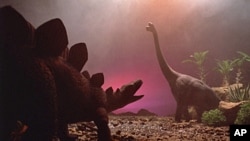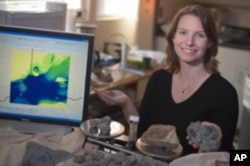The most recent mass extinction was 65 million years ago when the dinosaurs disappeared. That was one of five mass extinctions in earth's history - when the number of species dramatically declines. Scientists are eyeing the next mass extinction, which might be triggered by an invasive species.
According to Ohio University paleo-geologist Alycia Stigall, the sixth era of mass extinction is already under way. It began about a million years ago when big animals like wholly mammoths and saber tooth cats went extinct.
Collapse
Stigall sees clues to a modern apocalypse in the fossil record from the Devonian period 360 million years ago.
The Devonian was an era of mass extinction, when marine ecosystems completely collapsed, and reefs disappeared from the world's oceans. Sea levels rose and fell. Continents moved closer together. The stage was set for safe passage of invasive species. The invaders captured resources and adapted to their new living conditions, overwhelming native species.
Stigall says it was a huge change in how the ecosystem was structured. "What you realize is that the main organisms that are dominant in the rocks suddenly change. So the major groups of organisms, the major types of corals, the major type of shell fish, that we see beneath the 'biodiversity crisis interval' are completely different from the major groups of organisms that we see afterwards."
Bio-diversitycrisis
Species go extinct at regular intervals in earth's history, but the mass extinction during the late-Devonian was unlike any other in the planet's history. The formation of new species came to a halt. Stigall calls it a "bio-diversity crisis." "These new groups that are trying to become a new species, rather than to be able to expand their population and be successful, they get out competed for resources and just go extinct."
Stigall sees parallels with our world, in which human activities - agriculture, industry, population growth and urbanization - are promoting invasives, accelerating habitat loss and pushing species toward extinction.
"Evolution of new species or speciation is harder to see because the process of speciation takes between 10,000 and 50,000 years. Whereas you could drive a species extinct in a decade."
Stigall adds that if invasive species could trigger a mass extinction 360 million years ago, similar forces could be at work today. "What we can see from this is that things that are very limited or specialized in their ecology are the types of species that are both more likely to go extinct and less likely to have successful speciation down the line. So we may want to focus resources on species that are a little more broadly adapted that are still in their natural local habitats."
According to Stigall, the rate of species loss today is higher than anything documented in the fossil record. "We are looking at basically a whole series of potential effects that line up very well with the worst mass extinctions that occurred, which was 250 million years ago where 96 percent of the earth's species went extinct."
Stigall says her study underscores the long-term impact of invasive species. "The more we know about this process," she says, "the more we will understand how best to preserve bio-diversity." The work is published in PloS ONE.
















